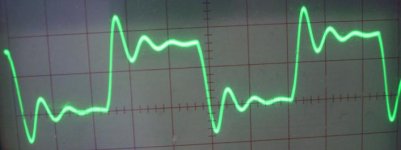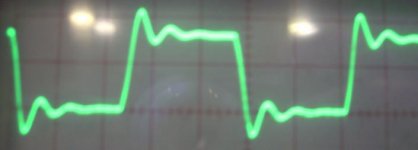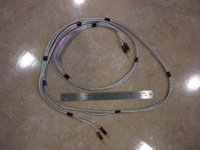john curl said:Trying to argue with you at this point is useless. You MUST include significant headroom, just like an auto, to be at its best, needs a greater top speed potential than you would normally drive at. Now please don't tell me that this auto analogy is wrong. I once owned a Renault Dauphine with 32HP for 95,000 miles, and know that more horsepower would have been very convenient in many occasions.
 I can't argue with that.
I can't argue with that.I don't doubt the legitimacy of your measurements for one moment or the value of your tried and tested rule of thumb. I just like to make a clear distinction between an implementation rule of thumb and a performance requirement. As you know, sometimes, not always, but sometimes innovation in implementation requires a fresh approach that is bounded only by the original requirements.We usually add a factor of about 5 for worst case effortless headroom for slew rate. We developed this 'rule of thumb' from 100's, YES, 100's of test measurements over a period of years.
i am sorry .....
personally i moove out of this thread ....i see no longer reason to follow all this ....
i presume when the space ship arrives to venus i will be notified ....
thank you people many good things were said here ....
regards sakis
personally i moove out of this thread ....i see no longer reason to follow all this ....
i presume when the space ship arrives to venus i will be notified ....
thank you people many good things were said here ....
regards sakis
I decided to make some measurements of my amp driving a real spkr load. Here are the results, warts and all, so feel free to comment either way.
Source - B&K function generator - rise time & fall time <90nS
Amplifier input RC filter: 220 Ohms and 1nF to ground
Output inductor: 13t of 2mm copper wire on 25mm former in parallel with 2.2 Ohms
Zobel: 10Ohms in series with 0.1uF 600V direct from amp output to ground (before Inductor)
Source - B&K function generator - rise time & fall time <90nS
Amplifier input RC filter: 220 Ohms and 1nF to ground
Output inductor: 13t of 2mm copper wire on 25mm former in parallel with 2.2 Ohms
Zobel: 10Ohms in series with 0.1uF 600V direct from amp output to ground (before Inductor)
Re: 'mass'
 Most likely.
Most likely.
Does it follow that high OL distortion necessitates high closed loop slew rate?
Edmond Stuart said:Theoretically, we don't need more slew rate than the max. SR of the input source. In real life however, most amplifiers (i.e. amps with a high degree of global NFB) show up a direct connection between SR, (open loop) bandwidth and distortion. Think of the Miller compensation for example. The higher the Miller cap ('mass', using your terminology) the less bandwidth. That means less NFB loop gain and more distortion.
So most likely that an amp with only 10V/us SR produces far more distortion than an amp with 100V/us SR.
 Most likely.
Most likely.Does it follow that high OL distortion necessitates high closed loop slew rate?
totally off topic
Hi John,
Welcome to the club of former Dauphine drivers. 🙂
Once I owned three of them: the ordinary Dauphie, then the Gordini version and finally a R1093, a special rally version with 55HP under the hood. Only 2140 were produced. Mine was further tuned and had a top speed of 170km/h.
(As some people seem to believe, 'R' does not stand for rally, neither does 1093 stand for1093cc. It's just a type number)
Did you know there was even an (American) electric version? Very rare!
http://en.wikipedia.org/wiki/Henney_Kilowatt
Cheers,
Edmond.
john curl said:...............
I once owned a Renault Dauphine with 32HP for 95,000 miles, and know that more horsepower would have been very convenient in many occasions.
...............
Hi John,
Welcome to the club of former Dauphine drivers. 🙂
Once I owned three of them: the ordinary Dauphie, then the Gordini version and finally a R1093, a special rally version with 55HP under the hood. Only 2140 were produced. Mine was further tuned and had a top speed of 170km/h.
(As some people seem to believe, 'R' does not stand for rally, neither does 1093 stand for1093cc. It's just a type number)
Did you know there was even an (American) electric version? Very rare!
http://en.wikipedia.org/wiki/Henney_Kilowatt
Cheers,
Edmond.
If I assume that every 1cm of spkr cable is 5nH, then total spkr cable inductance of spkr cable is 3uF. I estimate the inductance of the output inductor at 2.7uH (calculated).
here is the spkr cable
here is the spkr cable
Any chance of the response with 3m speaker cable driving a speaker and no capacitor?
PS: 5nH/cm will be a significant underestimate because it doesn't take the area enclosed by the two conductors into account. If you describe the cable, someone better informed than I might be able to estimate the inductance for you.
PS: 5nH/cm will be a significant underestimate because it doesn't take the area enclosed by the two conductors into account. If you describe the cable, someone better informed than I might be able to estimate the inductance for you.
Re: Re: 'mass'
Sorry, I don't see the connection.
edit: What are you aiming at?
traderbam said:Most likely.
Does it follow that high OL distortion necessitates high closed loop slew rate?
Sorry, I don't see the connection.
edit: What are you aiming at?
Bonsai said:Next picture is with 0.1uF across the speaker terminals. Spkr driven in all cases via 3m skr cable. note the slight kinks at the waqveform edges.
Hi Bonsai,
First, interesting work!
Next, can you tell us what the impedance is of that particular speaker at say 100kHz and 1MHz? If it deviates from the rated impedance, you might repeat the measurements with a more correct load by means of a RC Zobel right at the speaker connections.
Cheers,
Edmond.
edit: or just use a pure resistive dummy.
Sorry, guys, I will be away on business for the next week - maybe next week end I can try some more experiments.
BTW (you'll love this) I shorted out my output coil with a 100mm crocodile clip, and the waverform at the speaker cable showed no observable difference on the scope. I can only assume the spkr and cable inductance swamped the output coil inductance.
Next experiment I want to try is a 1uF right across the spkr terminals. My bet is without inductor the amp oscillates and with the inductor it does not.
BTW (you'll love this) I shorted out my output coil with a 100mm crocodile clip, and the waverform at the speaker cable showed no observable difference on the scope. I can only assume the spkr and cable inductance swamped the output coil inductance.
Next experiment I want to try is a 1uF right across the spkr terminals. My bet is without inductor the amp oscillates and with the inductor it does not.
Sorry Edmond - I cannot anwer your question. I looked on the web, but found no impeadance curves or anything.
- Home
- Amplifiers
- Solid State
- Function of Output Inductor






